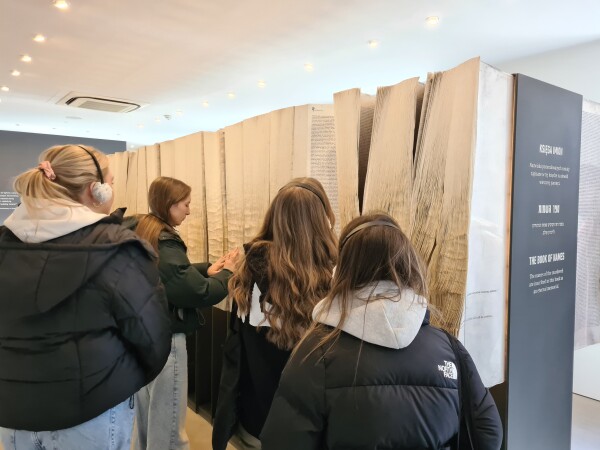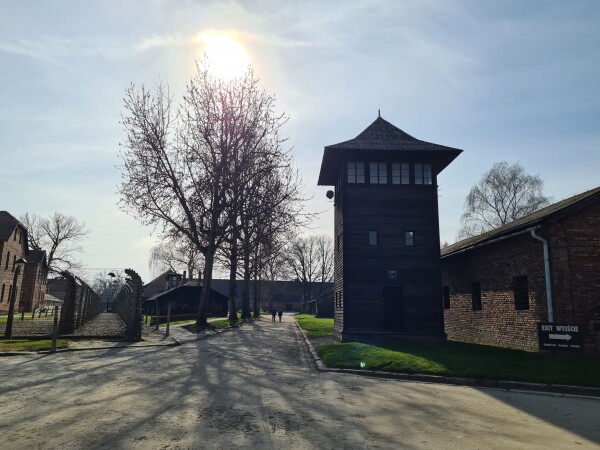Lessons from Auschwitz
19th April 2024
Before the Easter break, Mr Hamilton led a group of six Sixth Form students to Poland for the day. This is part of the Holocaust Educational Trust’s (HET) seminal work on ensuring that the next generation prevents a tragedy like the Holocaust from ever being repeated. This year, the HET took approximately 190 students from the South West Dudley areas to Poland as part of their annual Lessons From Auschwitz project. Students are currently completing a follow-up project to explore what they have learned and how this can be disseminated in Windsor or our local area.
Read on to find out what the day was like from Mr Hamilton’s perspective, as well as our key takeaways. If you’re in Year 12, consider applying next year.
Auschwitz Memorial Site
Our first destination was the original site for Auschwitz. We arrived there after a 4am start at Birmingham International. We’d flown to Poland and were taken straight there. The camp was not originally designed as a mass extermination camp, but many people were unfortunately killed there. We had a tour guide for the duration of the visit, and he spoke us through the whole process, from selection and deception, to when prisoners were killed. When we first entered the site, the sombre atmosphere was striking. It worsened when we passed an urn containing the bones and ashes of some of the people who had been imprisoned there.
As we moved around the site, we were taken through exhibits showing how the Nazis had exploited their victims, by stealing their clothes, their possessions, their glasses and their luggage, reusing items like gold teeth and rings. The most shocking part of this visit was when we walked through a corridor, only to be greeted by 40,000 pairs of shoes.
Forty-thousand.
It was simply indescribable. As part of our Year 9 lessons on the Holocaust, the History Department shows students images of rings and shoes, to get across the human side of the experience. Seeing these things in person is so, so different to seeing them in photos. Words escaped me.
Then came the next room. Hundreds, if not thousands, of locks of hair, stolen from the victims of the Holocaust when they were dehumanised and stripped of their entire personalities. On the way into this room and into the next were several hundred images of prisoners, which were taken in the earlier days of the site. The most striking was of one man, who looked deathly sick, likely due to the conditions he would have suffered through living in a ghetto before arriving at Auschwitz. The image stated when the man had been brought into the camp and when he died; the time difference was just three days.
Three days.
Afterwards, we walked through the gas chamber and passed a hangman’s pedestal. Walking through the chamber, knowing what had happened there, was one of the hardest parts of the trip.
I don’t think that we should dwell on difficult images when we teach about the Holocaust. Instead, as an act of remembrance, I think that it’s more important, and more powerful, to focus on the people who were imprisoned and murdered there, rather than the cruel acts that they were subjected to.
In fact, the visit ended in a room dedicated to a huge book. The pages were the size of floor-length mirrors and it extended the length of a house. Within were the names of three million Jewish people who had died, when and where, during the Holocaust. It is an act of remembrance and of defiance, against the Nazis who had stripped their prisoners of their identities completely, to rehumanise them. Around six million Jewish people died during the Holocaust, so the book remains incomplete.
One day, it is hoped that the book will be completed.

Birkenau
The final part of the trip was the hardest. Walking towards Birkenau, which was designed for mass extermination from the very beginning, left many of us stunned into silence. Seeing the fake train station, created to deceive prisoners into believing that they had reached a safer place than where they had been before, sent chills down my spine.
Our tour guide stayed with us for this part of the trip. He explained that the camp was so large that it was the size of 200 football stadiums. I could barely see the edge of the camp from where I stood. The conditions in the barracks were absolutely horrific.
I had visited concentration camps before – Saschenhausen about 10 years ago, and Dachau at the start of this year – but in terms of sheer scale, nothing compared to this.
We moved towards where the gas chamber once stood – demolished by Nazis in haste before the camp could be liberated – where a Rabbi gave a very powerful speech. He sang a psalm in Hebrew, spoke on the dangers of Holocaust Denial, and the responsibility that we all have to remember those who were killed.
He stated that if we were to hold a minute’s silence for every single one of the million Jewish people who were murdered there, we would be sat in silence for two years. And still, even that would not be enough.
His words echoed around the camp.
A few students from the trip, from other schools, were chosen to read excerpts from poems, and the Secretary of State for Education, Gillian Keegan, who’d joined us on the trip, read the final one.
We lit candles and placed them by the memorial site, before making the sombre journey back to the airport.
This was one of the most valuable experiences of my teaching career. I don’t feel comfortable sharing many of the limited photos that I took that day because it’s far more powerful to see these memorial sites with your own eyes.
I implore you to go one day too.
Mr Hamilton


